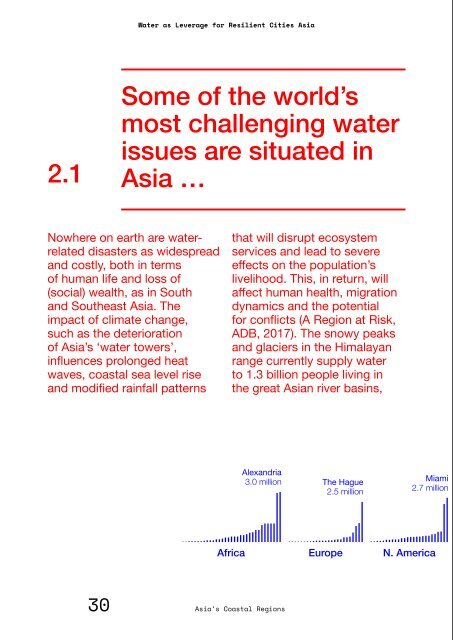Water as Leverage- Setting the scene for a call for action
- No tags were found...
You also want an ePaper? Increase the reach of your titles
YUMPU automatically turns print PDFs into web optimized ePapers that Google loves.
<strong>Water</strong> <strong>as</strong> <strong>Leverage</strong> <strong>for</strong> Resilient Cities Asia<br />
<strong>Setting</strong> <strong>the</strong> Scene <strong>for</strong> a Call <strong>for</strong> Action<br />
Content<br />
2.1<br />
Some of <strong>the</strong> world’s<br />
most challenging water<br />
issues are situated in<br />
Asia …<br />
Nowhere on earth are waterrelated<br />
dis<strong>as</strong>ters <strong>as</strong> widespread<br />
and costly, both in terms<br />
of human life and loss of<br />
(social) wealth, <strong>as</strong> in South<br />
and Sou<strong>the</strong><strong>as</strong>t Asia. The<br />
impact of climate change,<br />
such <strong>as</strong> <strong>the</strong> deterioration<br />
of Asia’s ‘water towers’,<br />
influences prolonged heat<br />
waves, co<strong>as</strong>tal sea level rise<br />
and modified rainfall patterns<br />
that will disrupt ecosystem<br />
services and lead to severe<br />
effects on <strong>the</strong> population’s<br />
livelihood. This, in return, will<br />
affect human health, migration<br />
dynamics and <strong>the</strong> potential<br />
<strong>for</strong> conflicts (A Region at Risk,<br />
ADB, 2017). The snowy peaks<br />
and glaciers in <strong>the</strong> Himalayan<br />
range currently supply water<br />
to 1.3 billion people living in<br />
<strong>the</strong> great Asian river b<strong>as</strong>ins,<br />
but this supply shows<br />
clear signs of decre<strong>as</strong>ing.<br />
With <strong>the</strong> diminishing of <strong>the</strong><br />
natural storage capacities<br />
of glaciers and <strong>the</strong> outburst<br />
of glacial lakes, <strong>the</strong> risks of<br />
flooding and water shortages<br />
incre<strong>as</strong>e. Climate change<br />
also raises precipitation, and<br />
thus augments <strong>the</strong> frequency<br />
and intensity of heavy rainfall<br />
events, particularly affecting<br />
South and Sou<strong>the</strong><strong>as</strong>t Asia.<br />
Coupled with a me<strong>as</strong>ured<br />
incre<strong>as</strong>e of tropical cyclone<br />
strength and <strong>the</strong> collateral<br />
hazard of sea level rise, tidal<br />
floods will also occur more<br />
often. Eventually, Asian cities<br />
will account <strong>for</strong> 83% of <strong>the</strong><br />
world’s population affected by<br />
sea level rise.<br />
Amount of people affected by sealevel<br />
rise. The three-degree world:<br />
<strong>the</strong> cities that will be drowned by<br />
global warming, Josh Holder, Niko<br />
Kommenda and Jonathan Watts <strong>for</strong><br />
The Guardian, November 3, 2017.<br />
Shanghai<br />
17.5 million<br />
Hong Kong<br />
8.4 million<br />
Osaka<br />
5.2 million<br />
Alexandria<br />
3.0 million The Hague<br />
2.5 million<br />
Miami<br />
2.7 million<br />
Rio de Janeiro<br />
1.8 million<br />
Africa Europe N. America S. America<br />
Asia<br />
30<br />
Asia’s Co<strong>as</strong>tal Regions<br />
PART 1 / From Global <strong>Water</strong> Issues to a Call <strong>for</strong> Action<br />
31


















